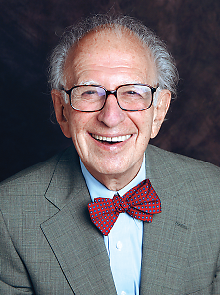Kandel Details Brain’s Role in Growth and Loss of Memory
Abstract
Some interesting molecules help distinguish age-related memory loss from Alzheimer’s disease and suggest promising new avenues for research.
“Memory is the glue that holds our mental life together,” psychiatrist and Nobel laureate Eric Kandel, M.D., said at APA’s 2014 annual meeting in New York in May. “Without memory, each moment in life is an isolated fragment.”

Nobel Prize winner Eric Kandel, M.D., explains which brain areas are assigned memory-related tasks and how age-related memory loss differs from that in Alzheimer’s disease.
He spoke to a large crowd that waited patiently to get through a security screening mandated by the presence of Vice President Joe Biden, who was scheduled to speak later that day in the room above. The audience was rewarded with Kandel’s insights into age-related memory loss, a new area of interest that builds on his longstanding work on memory with the sea slug Aplysia and with mice.
Two questions have bedeviled researchers into human memory, said Kandel, a University Professor at Columbia University and a senior investigator at the Howard Hughes Medical Institute. Where in the brain is memory stored, and what are the mechanisms by which memory storage occurs?
In the 1950s, Karl Lashley postulated that there was no localization of memory. Not long after, however, Wilder Penfield at McGill University, in removing scar tissue from the brains of injured patients, found that when he stimulated parts of the medial temporal lobe of the brain, including the hippocampus, the patients developed hallucinations or remembered experiences from earlier in life.
Those studies thus suggested that there were specific areas of the brain involved in memory, especially the hippocampus, which converts new short-term into new long-term memory.
“Age-related memory loss is tied to explicit memory storage,” said Kandel. Explicit memory covers facts, events, objects, people, and places. It involves the medial temporal lobe and the hippocampus and requires conscious attention. In contrast, implicit memory covers procedural and motor skills.
“Learning leads to strengthening of synaptic connections,” he pointed out. “This is the fundamental principle of learning and varies as a function of repetition.”
In short-term memory, functional increases in strength occur at preexisting synaptic connections. This occurs when presynaptic neurons in the hippocampus release glutamate, which acts on a postsynaptic NMDA receptor, allowing the influx of calcium, which in turn activates the enzyme calmodulin. That action then leads to the insertion of additional AMPA receptors that strengthen the synapse. No growth is associated with that process.
“However, with repetition that leads to long-term memory, there is also an alteration in gene expression that leads to growth of new synaptic connections and creation of a novel maintenance mechanism that can, in principle, carry the memory for your lifetime,” Kandel explained.
This process involves a prion, he said. In mice, dopamine converts the soluble form of the prion to the aggregated form, which is self-perpetuating and regulates local protein synthesis.
“Without that process, you can grow new synapses, but they retract and you cannot retain memory,” he said. “Reconsolidation uses this mechanism.”
By examining brains at autopsy of people who were aged 40 to 90 and who did not have Alzheimer’s disease, Kandel and his colleagues found that there is a systematic decrease over the human lifespan in the dentate gyrus—the area where age-related memory loss is thought to begin—of both the mRNA and the protein of RbAp48, a histone acetylase that regulates CPEB mediated gene expression. They then turned to mice and found that old mice also had a deficit in RbAp48 in the dentate gyrus. When they next inhibited RbAp48 in young mice, they recapitulated age-related memory loss and the spatial pattern of hippocampal dysfunction in aging wild-type mice. Moreover they could rescue age-related memory loss in old mice by enhancing the expression of RbAp48.
Such evidence helps differentiate between age-related memory loss and Alzheimer’s disease, he said. The former starts when people are in their 40s, involves the dentate gyrus, and evinces decreases in RbAp48 mRNA and its protein. The latter begins between ages 65 and 70, is localized in the entorhinal cortex, and shows no RbAp48 abnormalities.
Curiously, some recent research also shows the effects of the body on the aging brain.
Kandel’s Columbia University colleague, Gerard Karsenty, M.D., Ph.D., a professor of genetics and development, has shown that osteoblasts in bone release a hormone, osteocalcin, that is important for insulin secretion, production of testosterone, energy expenditure, brown fat, and insulin sensitivity.
“He also found that it’s important for psychiatry in almost all of its dimensions,” said Kandel. Osteocalcin boosts adult neurogenesis, serotonin, and dopamine, while decreasing GABA.
“These act on cognitive processes in the brain,” he said. “That is helpful for anxiety and depression and is especially helpful for spatial learning and memory.”
Injection of osteocalcin into the dentate gyrus enhances memory performance of both old and young mice. Since aging is associated with bone loss and a resulting decrease in osteocalcin release, it might contribute to age-related memory loss. Vigorous exercise builds bone mass, which may explain the beneficial effects of exercise on cognition.
“This is what your mother told you, and as your father, I’m telling you the same thing again,” Kandel concluded. ■



